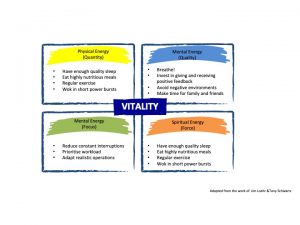“Managing energy, not time, is the fundamental currency of high performance. Performance is grounded in the skilful management of energy”
– Tony Schwartz
Have you ever noticed how exceptional leaders who consistently deliver exceptional results personify the same traits? They tend to lead by example in the truest sense of this phrase. They not only seem to continue giving and delivering but they do it in a style that personifies confidence, fulfilment and passion.
With the holiday season on the very near horizon, a perfect opportunity presents itself to pause and take stock of both our own energy and vitality, and the effect – positive, negative or neutral – that it has on our teams and colleagues.
The lead up to the end of the calendar year is often one of the busiest, which means it is crucial to preserve energy, and to ensure that precious vitality isn’t swallowed up by the intensity of pre-holiday deadlines. With a new year on the horizon, maintaining your vitality and energy now is also a key step in preparing for a successful start to the new year.
We can begin this process of self-reflection by thinking of the leaders you have worked with who represent what it means to be ‘fully alive’ and brimming with vitality. How did they influence you, inspire you, or make you feel? No doubt you just felt better for being around them – more confident, capable and energetic.
These are the leaders who tend to inspire you and have a way of breathing life and vitality into both people and projects. Conversely if you have ever worked with people who are constantly tired, stressed or drained of energy and enthusiasm they invariably leave you feeling like you’ve had the life sucked right out of you. You walk out of meetings feeling deflated, directionless and unmotivated. One group radiates vitality and the other drains it.
The reality is when an organisation’s leaders and people are running on empty tanks, everything suffers. It is the loss of personal vitality that has a definable cost to the business and heavily impacts on both productivity and profitability. If we want to build and/or lead businesses rich in these things we need to start paying attention to the health and vitality of ourselves as leaders so that we can positively impact our people and our clients and customers.
Business vitality is often referred to as the degree to which an organisation is successful in the eyes of their customers, employees and shareholders. Measures of vitality will include client and employee retention, stock price, profits, revenue growth and operating costs.
Often referred to as the ‘soft measures’ things such as public trust, innovation, collaboration, employee well-being and employee engagement are also critical. More and more organisations though are realising that these so-called ‘soft measures’ are better viewed as the critical measures. For it is these critical measures that determine and drive the hard measures.
As the speed at which we do business continues to accelerate and the market volatility and rate of change remains a constant, vitality is fast becoming recognised as a ‘must have’ leadership trait. This trait become even more pronounced in times of high intensity within organisations – and at this time of year in particular. In a climate where we as leaders are constantly being asked to do ‘more with less’ – less resources, less money and less people – we need to ensure that we know how to effectively manage our energy levels and not fall into the all too common trap of responding by simply working longer hours. ‘If I just do more, work harder things will improve and I will get through it’. When we don’t simply ‘get through it’ we start to question our capability, purpose and impact. And our people notice it. It can all too easily become a viscous cycle that if we aren’t careful robs us; our people; and our businesses of vitality, essence and spirit.
Jim Loehr and Tony Schwartz, authors of The Power of Full Engagement, argue that managing energy and not time is the key to personal and business vitality. They detail how mobilizing our key sources of energy, balancing how we spend it with how renew it and the energy habits we create, is critical to our success. Their recommended practices below for renewing the four sources of energy with the aim of becoming more vital are well worth examining.
Leadership vitality is about developing a critical life force that builds sustainable productivity and profitability. It starts with you. As the year draws to a close, I would encourage you consider how you can preserve your energy tanks to build vitality credits and how you can also begin to renew your sense of vitality over the break. You and your business will thank you for it.
Do you feel you are generating vitality as a leader? What do you notice when you feel your most energised within your business?

